Comparative Study on Complex Modulus and Dynamic Modulus of High-Modulus Asphalt Mixture
Abstract
:1. Introduction
2. Materials and Experimental
2.1. Materials
2.2. Mix Design
- TLext is the percentage of admixture (whetstone ratio), %
- K is specific surface area, m2/kg
- G is the ratio of aggregates with a particle size greater than 6.3 mm, %
- S is the ratio of aggregates with a particle size of 0.25 mm~0.63 mm, %
- s is aggregate ratio with a particle size of 0.063 mm~0.25 mm, %
- F is the ratio of aggregates with a particle size of less than 0.063 mm, %
- α is correlation coefficient related to aggregate density
- is density of aggregate, g/cm3
2.3. Test Methods
2.3.1. High-Modulus Mixture Performance Index Verification Test
2.3.2. Complex Modulus Test
2.3.3. Dynamic Modulus Test
3. Test Results and Analysis
3.1. Performance Verification of High-Modulus Mixture
3.2. Comparative Analysis of Modulus
3.3. Master Curve Analysis
3.4. Conversion Relation Model between Complex Modulus and Dynamic Modulus
3.5. Determination of Dynamic Modulus Evaluation Range of High-modulus Mixture
4. Conclusions
- 1.
- The performance of four types of high-modulus mixtures, EME-14 + France 15#, EME-14 + China 15#, HMAC-20 + France 15#, and HMAC-20 + China 15#, under level 1 to level 4, was verified; all met the performance index requirements of high-modulus mixtures.
- 2.
- Different loading control modes have a greater impact on the modulus and phase angle of the mixture. The frequency domain threshold of the master curve obtained by the SPT test is wider, the modulus value is larger, and the phase angle data dispersion is smaller than the CRT-2PT trapezoidal beam complex modulus test.
- 3.
- The relationship conversion model between dynamic modulus and complex modulus was established with good correlation. Based on the established correlation model, the dynamic modulus evaluation range of high-modulus mixtures under different evaluation temperature conditions was recommended.
- 4.
- Combined with the application of high-modulus mixtures in actual road engineering, the reliability of the recommended dynamic modulus range based on the calculation of the conversion model has been properly verified. The test results are all within the range of the dynamic modulus evaluation value given by the model.
Author Contributions
Funding
Institutional Review Board Statement
Informed Consent Statement
Data Availability Statement
Conflicts of Interest
References
- NF P98-141: 1999 Asphalt Mixture-Wearing Course and Base Course: High Modulus Asphalt Mixture-Definition-Classification-Characteristics-Production and Construction; French Standardization Association: Paris, France, 1999.
- Xia, X.P.; Zhang, R.N.; Fu, H.W. Characteristics and new development of high modulus asphalt mixture. Chin. Foreign Highw. 2005, 2, 123–127. [Google Scholar]
- Serfass, P.; Bense, P.; Pellevoisin, P. Properties and New Developments of High Modulus Asphalt Concrete. In Proceedings of the Lecture Series 8th International Conference on Asphalt Pavements, Seattle, WA, USA, 10–14 August 1997. [Google Scholar]
- Corte, J.F. Development and uses of hard grade asphalt and of high modulus asphalt mixes in France. Transp. Res. Circ. 2001, 503, 12–31. [Google Scholar]
- Zheng, J. Research on Durable High Modulus Asphalt Pavement Structure. Master’s Thesis, Chongqing Jiaotong University, Chongqing, China, 2013. [Google Scholar]
- Olidid, C.; Hein, D. Guide for Mechanistic-Empirical Design of New and Rehabilitated Pavement Structures. In Proceedings of the 2004 Annual Conference and Exhibition of the Transportation Association of Canada-Transportation Innovation-Accelerating the Pace, Québec City, QC, Canada, 19–22 September 2004. [Google Scholar]
- Zhou, F.; Scullion, T. Preliminary Field Validation of Simple Performance Tests for Permanent Deformation: Case Study. Transp. Res. Rec. 2003, 1832, 209–216. [Google Scholar] [CrossRef]
- Zhou, Q.H.; Sha, A.M.; Yang, Q. Experimental study on mechanical properties of high modulus asphalt concrete. J. Zhengzhou Univ. 2008, 3, 128–131. [Google Scholar]
- Witczak, M. Simple Performance Tests: Summary of Recommended Methods and Database; NCHRP-547; Transportation Research Board: Washington, DC, USA, 2005; pp. 2–7. [Google Scholar]
- Lee, H.J.; Lee, J.H.; Park, H.M. Performance evaluation of high modulus asphalt nlixtllres for long life asphalt pavements. Constr. Build. Mater. 2007, 21, 1079–1087. [Google Scholar] [CrossRef]
- Arnold, G.; Darcy, R.; Hall, S.; Mudgway, G. High Modulus Asphalt to Prevent Rutting at Intersections. In Proceedings of the 17th AAPA International Flexible Pavements Conference, Victoria, Australia, 13–16 August 2017; pp. 1–11. [Google Scholar]
- Amjad, H.K.; Lateif, R.H. Evaluating the Performance of High Modulus Asphalt Concrete Mixture for Base Course in Iraq. J. Eng. 2017, 23, 14–33. [Google Scholar]
- Xu, J.; Zhao, Y.; Liang, N. Life prediction of high modulus asphalt pavement based on fatigue cumulative damage. J. Chang’an Univ. Nat. Sci. Ed. 2017, 38, 26–33. [Google Scholar]
- France RST “Asphalt Mixture Design” Working Group. LPC Bituminous Mixtures Design Guide; Laboratoire Central des Ponts et Chaussées: Paris, France, 2010. [Google Scholar]
- Wang, X.D.; Sha, A.M.; Xu, Z.H. Dynamics Characteristics and Dynamic Parameters of Asphalt Pavement Materials; China Communications Press: Beijing, China, 2002; pp. 102–106. [Google Scholar]
- Zou, H.Z. Experimental research on dynamic modulus of asphalt mixture. Master’s Thesis, Chang’an University, Chang’an, China, 2013. [Google Scholar]
- You, Y.J. Research on the dynamic modulus of asphalt mixture. Master’s Thesis, Shandong Jianzhu University, Jinan, China, 2017. [Google Scholar]
- GB/T 36143-2018 High Modulus Anti-Fatigue Asphalt Mixture for Road; People’s Communications Press: Beijing, China, 2018.
- DB 13/T 2823-2018 Technical Guidelines for Highway High Modulus Asphalt Pavement Construction; Hebei Provincial Bureau of Quality and Technical Supervision: Hebei, China, 2018.
- DB 21/T1754-2009 Construction Specification for High Modulus Asphalt Mixtures; Renmin Communication Press: Shenyang, China, 2009.
- JTG F40-2004 Technical Specifications for Construction of Highway Asphalt Pavements; People’s Communications Press: Beijing, China, 2005.
- Huang, Y. Experimental Research on Dynamic Modulus of Asphalt Mixture Trapezoidal Beam. Master’s Thesis, Changsha University of Science and Technology, Changsha, China, 2015. [Google Scholar]
- Huang, Y.; Liu, Z.H.; Wang, X.D.; Li, S. Comparative study of dynamic modulus trapezoidal beam and SPT test of asphalt mixture. J. Cent. South Univ. 2017, 48, 3092–3099. [Google Scholar]
- Huang, Y.; Wang, X.D.; Liu, Z.H.; Zhou, X.Y.; Zhang, L. Experimental study on dynamic modulus trapezoidal beam of SAC13 asphalt mixture. Highw. Transp. Sci. Technol. 2017, 34, 7–14. [Google Scholar]
- Corté, J.-F.; Serfass, J.-P. The French approach to asphalt mixtures design: A performance-related system of specifications. Assoc. Asph. Paving Technol. 2000, 69, 794–834. [Google Scholar]
- CSN EN 12697-31 Bituminous Mixtures-Test Methods for Hot Mix Asphalt-Part 31: Specimen Preparation by Gyratory Compactor; The Commonwealth Standards Network: London, UK, 2007.
- CSN EN 12697-12 Bituminous Mixtures-Test Methods for Hot Mix Asphalt Part 12: Determination of the Water Sensitivity of Bituminous Specimens; The Commonwealth Standards Network: London, UK, 2008.
- CSN EN 12697-22 Bituminous Mixtures-Test Methods for Hot Mix Asphalt-Part 22: Wheel Tracking; The Commonwealth Standards Network: London, UK, 2020.
- CSN EN 12697-26 Bituminous Mixtures-Test Methods for Hot Mix Asphalt-Part 26: Stiffness; The Commonwealth Standards Network: London, UK, 2003.
- CSN EN 12697-24 Bituminous Mixtures-Test Methods for Hot Mix Asphalt Part 24: Resistance to Fatigue; The Commonwealth Standards Network: London, UK, 2012.
- Zhao, Y.Q.; Wu, J.; Wen, J. Determination and analysis of dynamic modulus of asphalt mixture and its master curve. Highway 2006, 8, 163–166. [Google Scholar]
- Ma, X.; Ni, F.J.; Chen, Y.S. Dynamic modulus test of asphalt mixture and prediction model. Chin. J. Highw. Transp. 2008, 21, 35–39. [Google Scholar]
- Luo, S.; Qian, Z.D.; Harvey, J. Research on dynamic modulus for epoxy asphalt mixtures and its master curve. Chin. J. Highw. Transp. 2010, 23, 16–20. [Google Scholar]
- Ma, L.; Zhang, X.N. Comparison of HMA dynamic moduli between indirect tension and uniaxial compression test modes. J. Highw. Transp. Res. Dev. 2009, 26, 11–17. [Google Scholar]
- Li, Q.; Li, G.F.; Wang, H.C. Effect of loading modes on dynamic moduli of asphalt mixtures. J. Build. Mater. 2014, 17, 816–822. [Google Scholar]
- Liu, Y. Research on Dynamic Response and Fracture Performance Based of Asphalt Mixture on Semi-Circular Bending Test; Harbin Institute of Technology, School of Transportation Science and Engineering: Harbin, China, 2009; pp. 3–7. [Google Scholar]
- Qian, Z.D.; Yang, Y.N.; Chen, T.J. Dynamic response of asphalt pavement under moving loads with low and variable speed. J. Cent. South Univ. 2015, 46, 1140–1146. [Google Scholar]

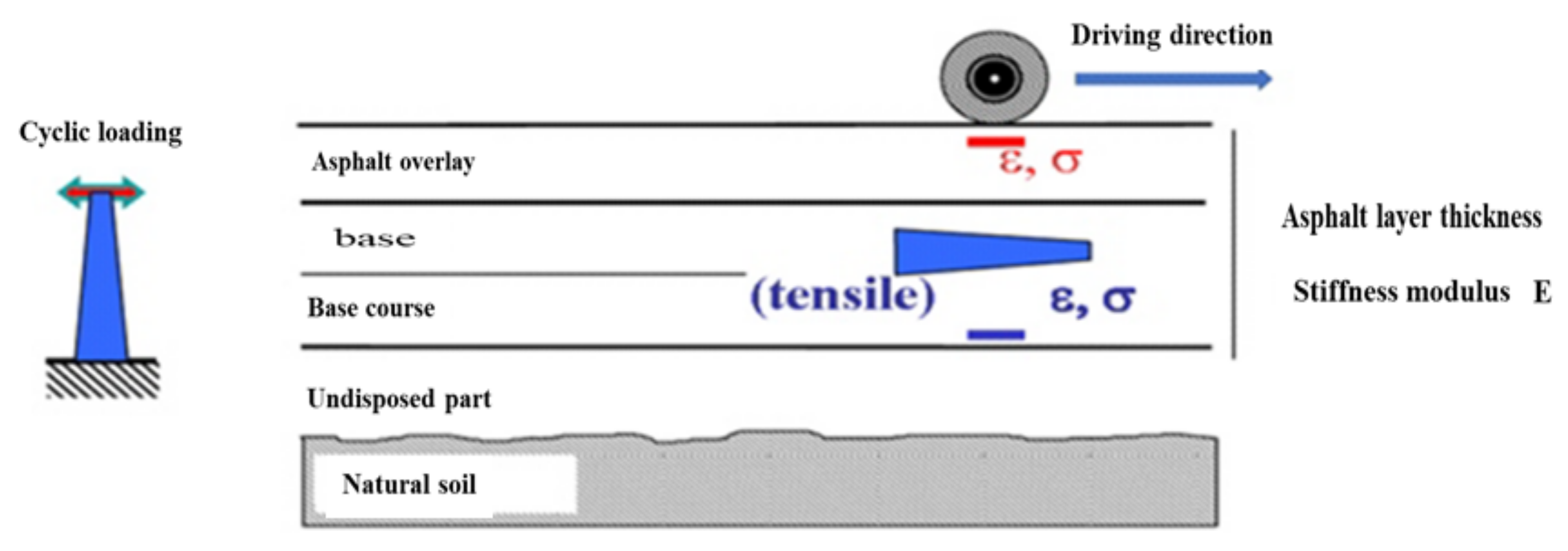
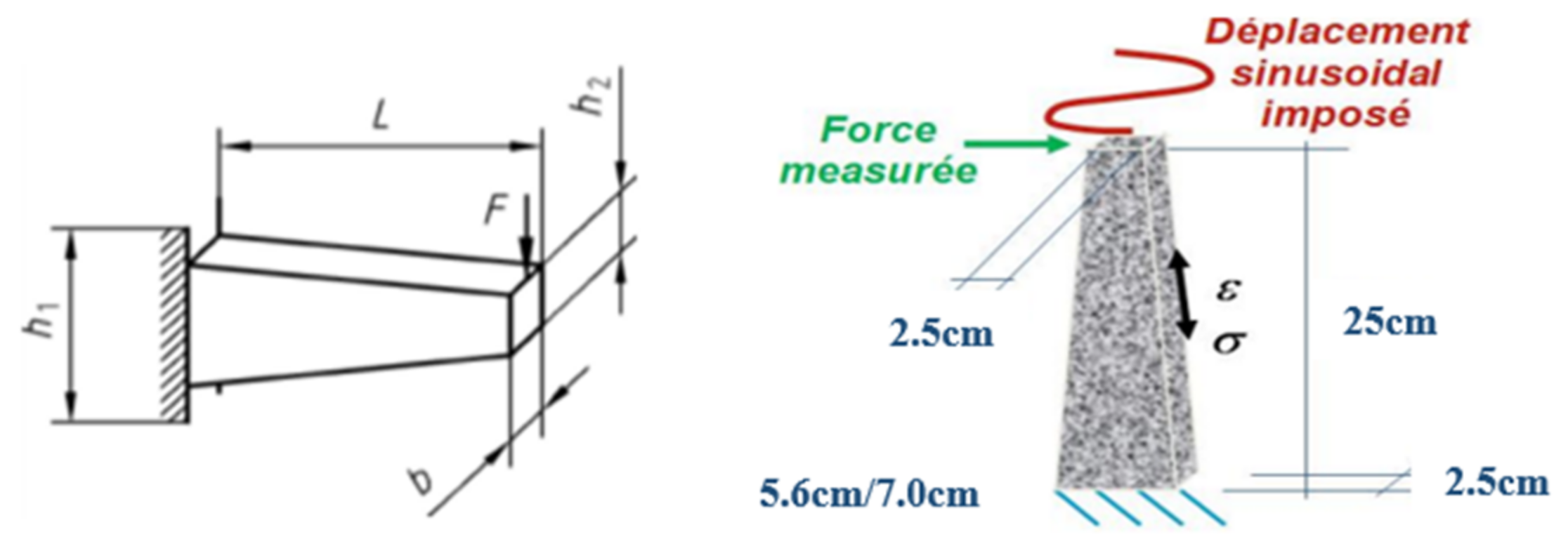


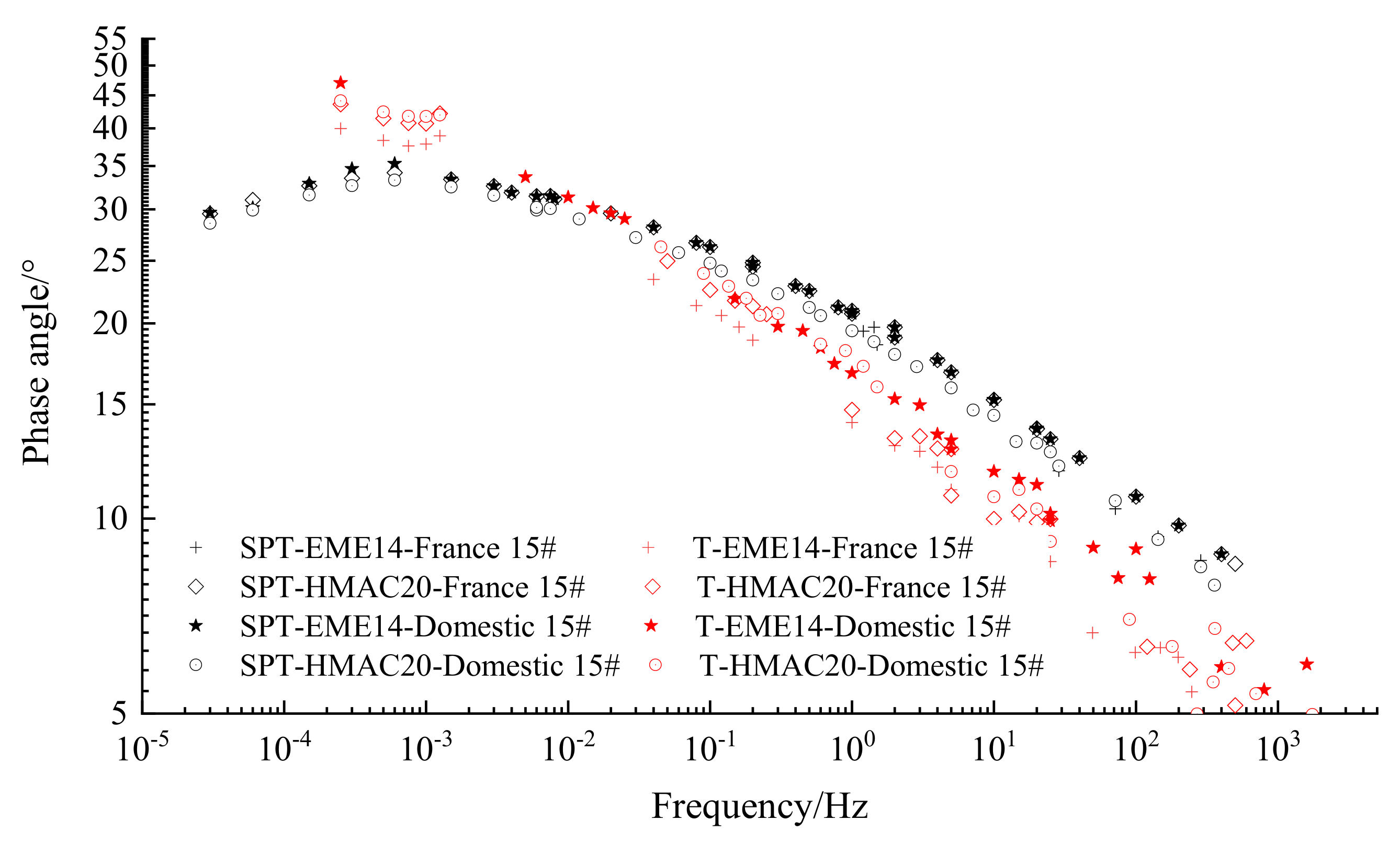

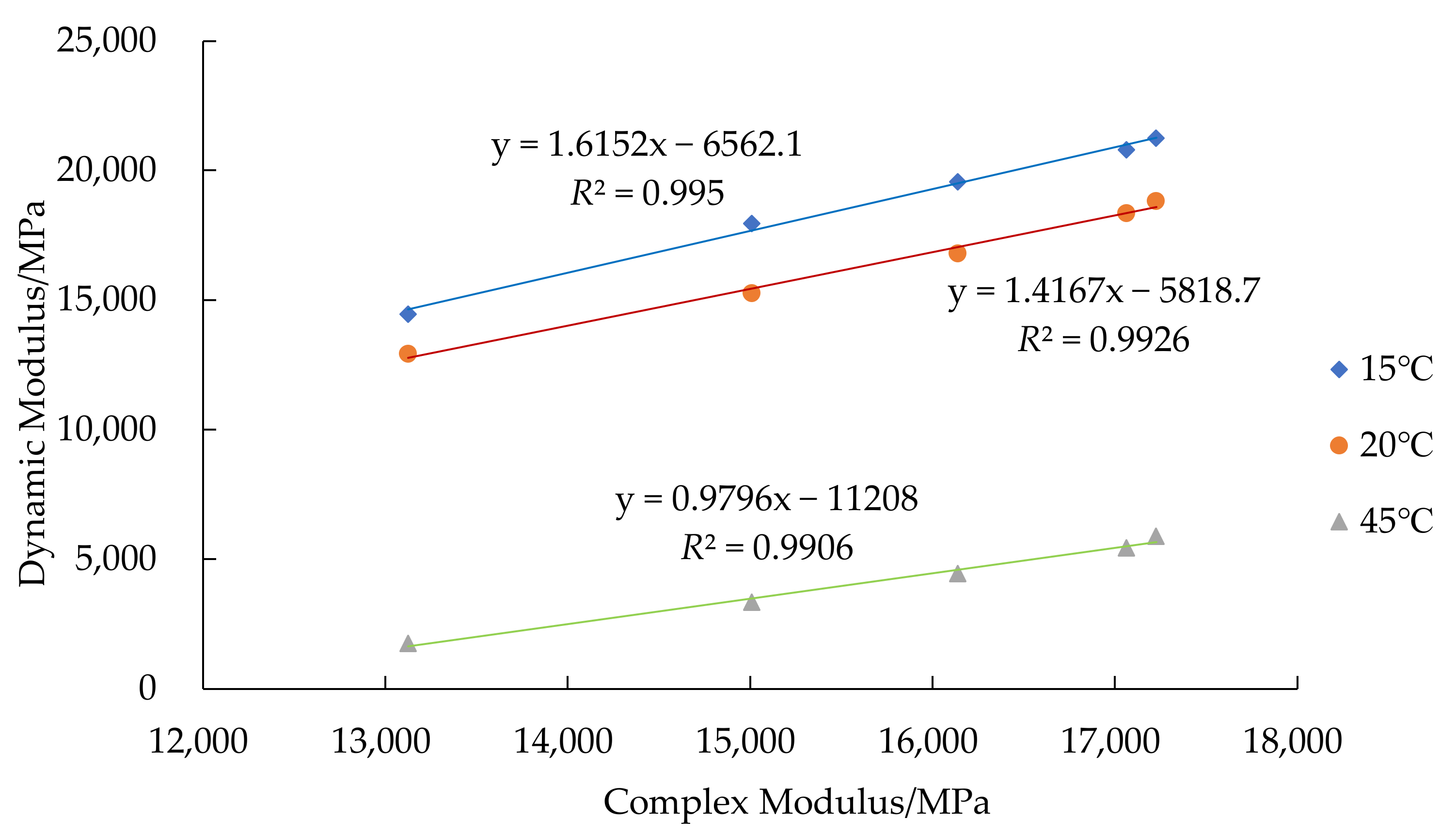

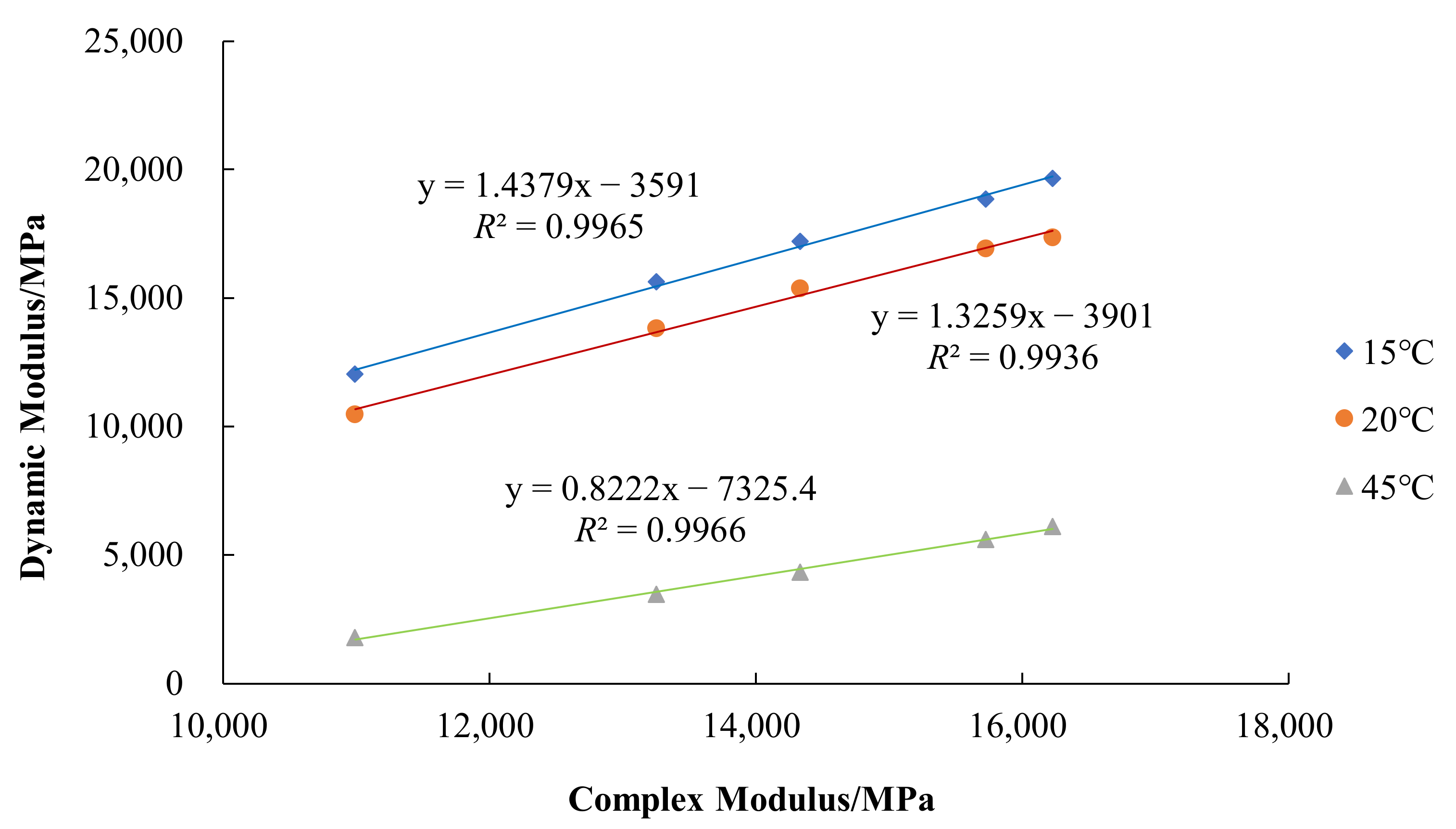

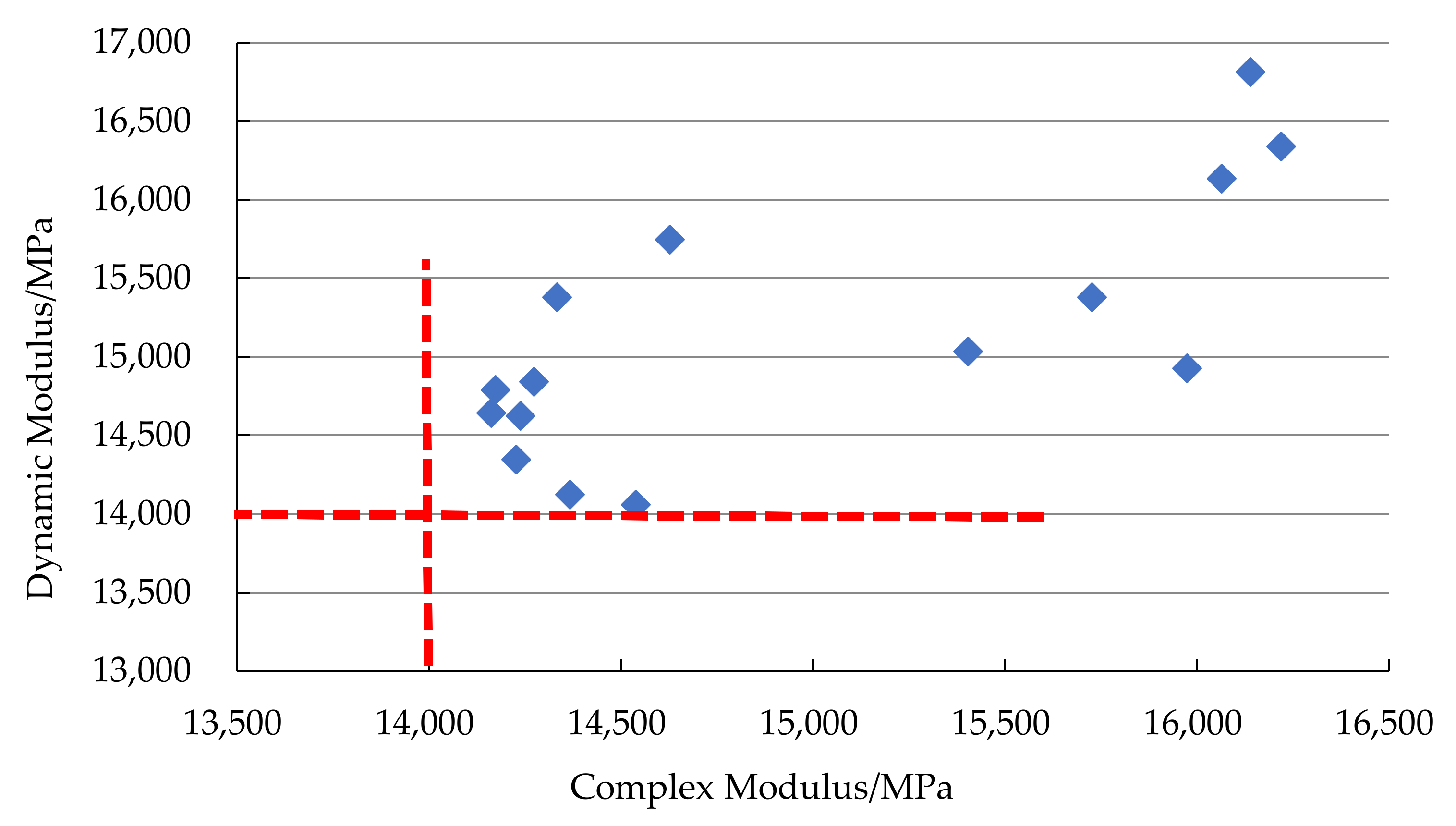
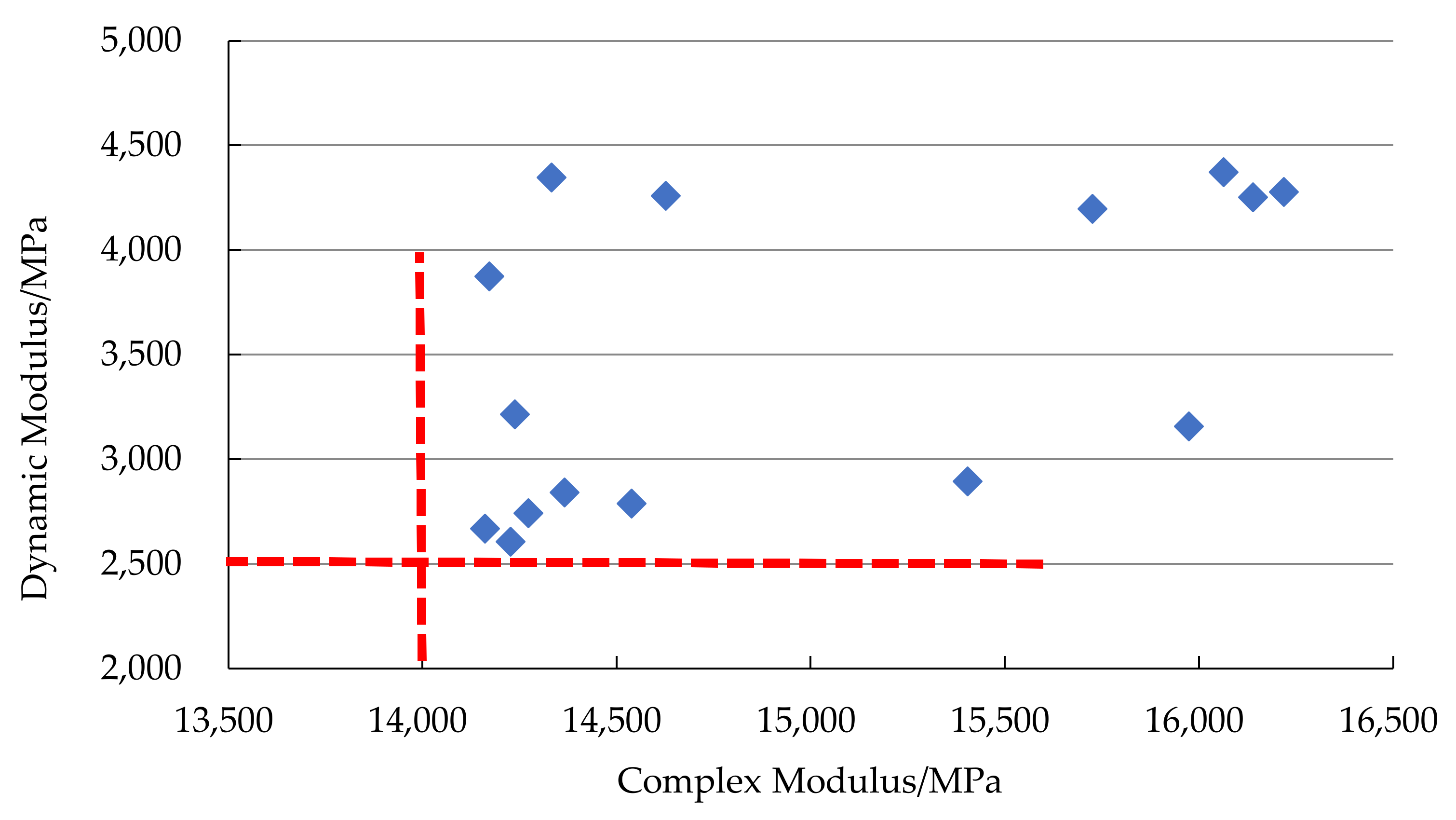
| Technical Index | Test Results | Index Requirements | ||
|---|---|---|---|---|
| Coarse aggregate | Apparent relative density | 15–20 mm | 2.762 | ≤2.50 |
| 10–15 mm | 2.732 | |||
| 5–10 mm | 2.746 | |||
| 3–5 mm | 2.758 | |||
| Water absorption rate (%) | 15–20 mm | 0.45 | ≤3.0 | |
| 10–15 mm | 0.32 | |||
| 5–10 mm | 0.45 | |||
| 3–5 mm | 0.63 | |||
| Crushing value (%) | - | 19.2 | ≤28 | |
| Needle flake content (%) | 15–20 mm | 3.5 | ≤18 | |
| 10–15 mm | 9.3 | |||
| 5–10 mm | 10.7 | |||
| Soft stone content (%) | 0.55 | ≤5 | ||
| Washing method <0.075 mm particle content (%) | 15–20 mm | 0.3 | ≤1.0 | |
| 10–15 mm | 0.6 | |||
| 5–10 mm | 0.4 | |||
| 3–5 mm | 0.9 | |||
| Adhesion to asphalt, grade | 5 | ≥4 | ||
| Fine aggregate | Apparent relative density | 2.644 | ≥2.5 | |
| Sand equivalent (%) | 67 | ≥60 | ||
| Angularity of fine aggregate (s) | 36 | ≥30 | ||
| Methylene blue (g/Kg) | 7 | ≤25 | ||
| Pilot Projects | China 15# | France 15# | |
|---|---|---|---|
| Penetration (100 g, 5 s, 25 °C)/0.1 mm | 15.2 | 16.8 | |
| Softening Point (5 °C)/°C | 64.25 | 66.6 | |
| Ductility (5 cm/min,15 °C) | Brittle | Brittle | |
| Solubility/% | 99.6 | 99.78 | |
| density (15 °C)/g/cm3 | 1.029 | 1.033 | |
| Flash point/°C | 280 | 344 | |
| dynamic viscosity/Pa·s | 6076 | 7219 | |
| RTFOT | Quality change/% | −0.31 | 0.051 |
| Residual penetration ratio/% | 78 | 71.6 | |
| Asphalt Material | 9.75Psi | 20Psi | ||
|---|---|---|---|---|
| Maximum Creep Deflection (mm) | Elastic Recovery Rate (%) | Maximum Creep Deflection (mm) | Elastic Recovery Rate (%) | |
| China 15# | 0.0039 | 82.1 | 0.0128 | 61.7 |
| France 15# | 0.0046 | 79.5 | 0.0104 | 65.4 |
| Particle Diameter (mm) | Mass Percentage of Particles Smaller Than a Certain Particle Diameter (%) | ||||
|---|---|---|---|---|---|
| EME-14 | HMAC-20 | Design Upper Limit | Design Lower Limit | Design Median | |
| 26.5 | 100 | 100 | 100 | 100 | 100 |
| 19 | 100 | 93.8 | 100 | 90 | 95 |
| 16 | 100 | 88.4 | - | - | - |
| 13.2 | 99.4 | 81.3 | - | - | - |
| 9.5 | 90.2 | 69.2 | 82 | 66 | 74 |
| 4.75 | 48.8 | 43.6 | 64 | 41 | 52.5 |
| 2.36 | 33.1 | 29.6 | 43 | 28 | 35.5 |
| 1.18 | 26.4 | 24 | - | - | - |
| 0.6 | 16.6 | 16.3 | - | - | - |
| 0.3 | 11.2 | 12.1 | - | - | - |
| 0.15 | 8.5 | 7.9 | - | - | - |
| 0.075 | 6.5 | 6 | 8 | 6 | 7 |
| Mixture Type | G (%) | S (%) | s (%) | f (%) | Oil-Stone Ratio/% | Abundance Coefficient | |
|---|---|---|---|---|---|---|---|
| EME-14 | 37 | 50.4 | 4.2 | 7.7 | 2.730 | 5.7 | 3.46 |
| HMAC-20 | 58.6 | 33.2 | 3.4 | 4.8 | 2.730 | 5.3 | 3.44 |
| Test Level | Test Item | Test Methods |
|---|---|---|
| Level 1 | Rotational compaction void ratio (%) | EN 12697-31 [26] |
| Water stability: Durex test (Compressive strength ratio, %) | EN 12697-12 (Method B) [27] | |
| Level 2 | High temperature stability: French wheel rutting test (30,000 times, 60 °C) | EN 12697-22 [28] |
| Level 3 | Stiffness modulus: complex modulus (MPa, 15 °C, 10 Hz/0.02 s) | EN 12697-26 [29] |
| Level 4 | Fatigue life: two-point bending fatigue of trapezoidal beam (10 °C, 25 Hz, 106 times, 130 με) | EN 12697-24 [30] |
| Test Parameters | Test Plan | |
|---|---|---|
| Complex Modulus of Trapezoidal Beam | Uniaxial Compression Dynamic Modulus | |
| Test piece size | Height: 250 ± 1 mm, thickness: 25 mm ± 1 mm Top bottom: 25 ± 1 mm, bottom: 56 mm/70 mm ± 1 mm | Diameter: 100 mm, height: 150 mm standard specimen |
| Strain level | 30 με | 75–125 με |
| Test temperature | 5, 15, 20, 30, 45 °C | 5, 15, 20, 30, 45 °C |
| Test frequency | 1, 5, 10, 15, 20, 25 Hz | 0.1, 0.2, 0.5, 1, 2, 5, 10, 20, 25 Hz |
| Number of parallel tests | 6 | |
| Test Level | Test Item | Test Results | Technical Index Requirements | |||
|---|---|---|---|---|---|---|
| China 15# | France 15# | |||||
| EME-14 | HMAC-20 | EME-14 | HMAC-20 | |||
| Level 1 | Rotational compaction void ratio (%) | 3.35 | 3.82 | 3.27 | 3.69 | <6% |
| Durex test (ITSR, %) | 100.23 | 101.25 | 101.22 | 101.92 | ≥70% | |
| Level 2 | French wheel track test (30,000 times, 60 °C, deformation rate) | 4.32 | 5.13 | 4.17 | 4.92 | ≤7.5% |
| Level 3 | Complex modulus (15 °C, 10 Hz, MPa,) | 16,219 | 14,027 | 16,139 | 14,333 | ≥14,000 MPa |
| Level 4 | Two-point bending fatigue of trapezoidal beam (10 °C, 25 Hz, 130 με, times) | 1,220,320 | 1,082,310 | 1,340,350 | 1,108,630 | ≥106 |
| Types | Void Ratio (%) | Loading Frequency (Hz) | Dynamic Modulus (MPa) | Phase Angle (°) | ||||
|---|---|---|---|---|---|---|---|---|
| 15 °C | 20 °C | 45 °C | 15 °C | 20 °C | 45 °C | |||
| EME-14 + China 15# | 3.76 | 25 | 22,232 | 18,591 | 5741 | 10.41 | 11.96 | 28.94 |
| 20 | 21,631 | 17,998 | 5358 | 10.74 | 12.39 | 28.76 | ||
| 10 | 19,932 | 16,340 | 4279 | 11.84 | 13.83 | 30.28 | ||
| 5 | 18,258 | 14,707 | 3367 | 13.17 | 15.41 | 31.54 | ||
| 2 | 15,973 | 12,549 | 2398 | 15.06 | 17.73 | 32.56 | ||
| 1 | 14,240 | 11,009 | 1838 | 16.61 | 19.52 | 32.33 | ||
| 0.5 | 12,570 | 9496 | 1402 | 18.32 | 21.40 | 31.71 | ||
| 0.2 | 10,442 | 7694 | 985 | 20.66 | 23.99 | 30.6 | ||
| 0.1 | 8934 | 6493 | 762 | 22.5 | 25.82 | 29.07 | ||
| EME-14 + France 15# | 3.82 | 25 | 20,456 | 18,836.5 | 5888.5 | 9.33 | 11.47 | 29.27 |
| 20 | 20,117 | 18,355.5 | 5450.5 | 9.78 | 11.71 | 29.26 | ||
| 10 | 18,771 | 16,816 | 4255 | 11.22 | 12.965 | 29.98 | ||
| 5 | 17,273 | 15,267 | 3141.5 | 12.54 | 14.425 | 30.45 | ||
| 2 | 15,254 | 13,230 | 2121.5 | 14.39 | 16.455 | 30.97 | ||
| 1 | 13,669 | 11,631.5 | 1730.5 | 15.82 | 18.125 | 30.47 | ||
| 0.5 | 12,116 | 10,194.5 | 1315 | 17.32 | 19.83 | 30.04 | ||
| 0.2 | 10,163 | 8385.5 | 935.1 | 19.49 | 22.21 | 29.22 | ||
| 0.1 | 8744 | 7168.5 | 734.1 | 21.12 | 23.94 | 27.24 | ||
| HMAC-20 + China 15# | 3.93 | 25 | 19,958 | 17,915 | 5955 | 10.99 | 11.96 | 28.94 |
| 20 | 19,065 | 17,246 | 5139 | 11.24 | 12.18 | 28.76 | ||
| 10 | 17,885 | 15,747 | 4261 | 12.49 | 13.44 | 30.28 | ||
| 5 | 16,254 | 14,280 | 3285 | 13.86 | 14.99 | 31.54 | ||
| 2 | 14,071 | 12,389 | 2197 | 15.93 | 16.98 | 32.56 | ||
| 1 | 12,466 | 10,797 | 1597 | 17.58 | 18.67 | 32.33 | ||
| 0.5 | 10,944 | 9445 | 1244 | 19.26 | 20.4 | 31.71 | ||
| 0.2 | 9015 | 7756 | 862.1 | 21.56 | 22.85 | 30.6 | ||
| 0.1 | 7722 | 6615 | 655.2 | 23.23 | 24.65 | 29.07 | ||
| HMAC-20 + France 15# | 3.76 | 25 | 19,675 | 17,374 | 6122 | 11.29 | 12.67 | 28.88 |
| 20 | 18,865 | 16,940 | 5612 | 12.21 | 13.07 | 29.05 | ||
| 10 | 17,227 | 15,382 | 4349 | 13.17 | 14.42 | 30.93 | ||
| 5 | 15,643 | 13,835 | 3478 | 14.31 | 15.91 | 31.72 | ||
| 2 | 13,552 | 11,906 | 2046 | 15.98 | 17.91 | 32.76 | ||
| 1 | 12,052 | 10,478 | 1804 | 17.26 | 19.49 | 32.59 | ||
| 0.5 | 10,620 | 9112 | 1386 | 18.57 | 21.16 | 31.16 | ||
| 0.2 | 8829 | 7426 | 1008 | 20.38 | 23.34 | 30.29 | ||
| 0.1 | 7604 | 6306 | 813 | 22.68 | 24.78 | 29.82 | ||
| Types | Void Ratio (%) | Loading Frequency (Hz) | Complex Modulus (MPa) | Phase Angle (°) |
|---|---|---|---|---|
| EME-14 + China 15# | 4.12 | 25 | 18,300 | 9.189264 |
| 20 | 17,684 | 9.547917 | ||
| 15 | 16,848 | 10.24761 | ||
| 10 | 16,219 | 10.40017 | ||
| 5 | 15,001 | 11.44451 | ||
| 1 | 12,085 | 11.96734 | ||
| EME-14 + France 15# | 3.93 | 25 | 17,226 | 8.582561 |
| 20 | 17,064 | 9.387128 | ||
| 15 | 16,550 | 9.942839 | ||
| 10 | 16,139 | 10.0863 | ||
| 5 | 15,010 | 10.78818 | ||
| 1 | 13,124 | 11.56282 | ||
| HMAC-20 + China 15# | 4.07 | 25 | 15,956 | 9.218034 |
| 20 | 14,842 | 10.34659 | ||
| 15 | 14,329 | 11.08765 | ||
| 10 | 14,027 | 10.79887 | ||
| 5 | 12,929 | 11.81575 | ||
| 1 | 10,284 | 12.015642 | ||
| HMAC-20 + France 15# | 4.15 | 25 | 16,228 | 9.977964 |
| 20 | 15,725 | 9.873416 | ||
| 15 | 14,835 | 10.23612 | ||
| 10 | 14,333 | 9.987529 | ||
| 5 | 13,255 | 10.85202 | ||
| 1 | 10,990 | 11.36823 |
| Mixture Type | Test Conditions | Conversion Model | Calculated | Recommended Value |
|---|---|---|---|---|
| EME-14 + China 15# | 15 °C, 10 Hz | y = 1.2964x − 1299 | 16,850 | ≥16,000 |
| EME-14 + France 15# | y = 1.6152x − 6562.1 | 16,050 | ||
| HMAC-20 + China 15# | y = 1.359x − 1367 | 17,659 | ||
| HMAC-20 + France 15# | y = 1.4379x − 3591 | 16,539 | ||
| EME-14 + China 15# | 20 °C, 10 Hz | y = 1.0471x − 638.39 | 14,021 | ≥14,000 |
| EME-14 + France 15# | y = 1.4167x − 5818.7 | 14,015 | ||
| HMAC-20 + China 15# | y = 1.3027x − 2530.1 | 15,707 | ||
| HMAC-20 + France 15# | y = 1.3259x − 3901 | 14,661 | ||
| EME-14 + China 15# | 45 °C, 10 Hz | y = 0.6366x − 5979.3 | 2933 | ≥2500 |
| EME-14 + France 15# | y = 0.9796x − 11208 | 2506 | ||
| HMAC-20 + China 15# | y = 0.7787x − 6548.8 | 4353 | ||
| HMAC-20 + France 15# | y = 0.8222x − 7325.4 | 4185 |
Publisher’s Note: MDPI stays neutral with regard to jurisdictional claims in published maps and institutional affiliations. |
© 2021 by the authors. Licensee MDPI, Basel, Switzerland. This article is an open access article distributed under the terms and conditions of the Creative Commons Attribution (CC BY) license (https://creativecommons.org/licenses/by/4.0/).
Share and Cite
Guo, L.; Xu, Q.; Zeng, G.; Wu, W.; Zhou, M.; Yan, X.; Zhang, X.; Wei, J. Comparative Study on Complex Modulus and Dynamic Modulus of High-Modulus Asphalt Mixture. Coatings 2021, 11, 1502. https://doi.org/10.3390/coatings11121502
Guo L, Xu Q, Zeng G, Wu W, Zhou M, Yan X, Zhang X, Wei J. Comparative Study on Complex Modulus and Dynamic Modulus of High-Modulus Asphalt Mixture. Coatings. 2021; 11(12):1502. https://doi.org/10.3390/coatings11121502
Chicago/Turabian StyleGuo, Licheng, Qinsheng Xu, Guodong Zeng, Wenjuan Wu, Min Zhou, Xiangpeng Yan, Xiaomeng Zhang, and Jincheng Wei. 2021. "Comparative Study on Complex Modulus and Dynamic Modulus of High-Modulus Asphalt Mixture" Coatings 11, no. 12: 1502. https://doi.org/10.3390/coatings11121502






